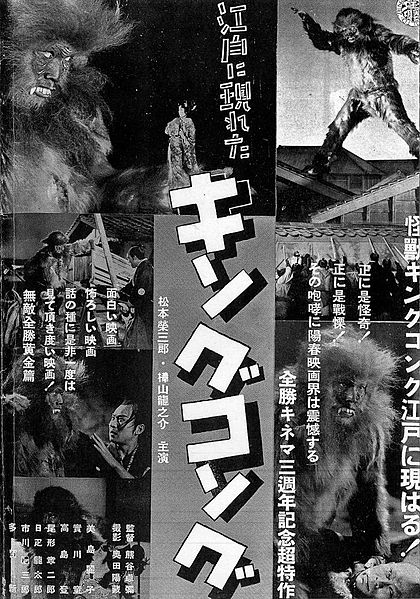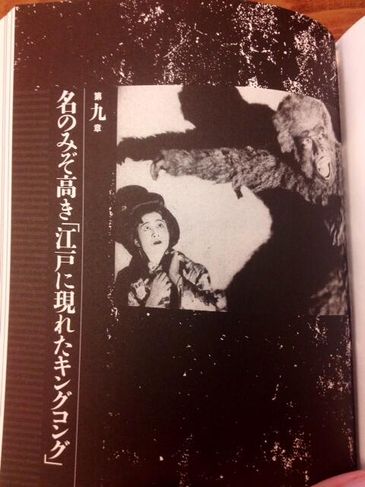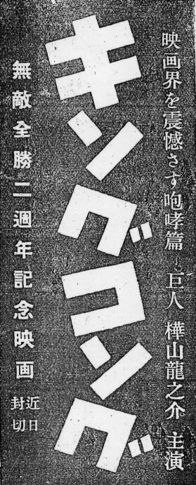The King Kong That Appeared in Edo (lost Japanese monster film; 1938): Difference between revisions
(Removed much false information and added a lot of new info taken from the various issues of Kinema Junpo.) |
No edit summary |
||
| (22 intermediate revisions by 12 users not shown) | |||
| Line 1: | Line 1: | ||
{{InfoboxLost | |||
|title=<center>The King Kong That Appeared in Edo (1938)</center> | |||
'''''King Kong | |image=KingKongEdo-KinemaJunpo14Apr38.jpg | ||
|imagecaption=Advertisement for the movie, taken from the April 14th, 1938 issue of ''Kinema Junpo''. | |||
|status=<span style="color:red;">'''Lost'''</span> | |||
}} | |||
'''''The King Kong That Appeared in Edo''''' is a two-part 1938 Japanese monster film. It can be considered a precursor to Japan's giant monster ''kaiju'' films that became popular in the 1950s, most famously ''Godzilla'' (1954). | |||
==Premise== | |||
The plot involves a woman who is mysteriously kidnapped and her father's attempts to offer a large sum of money for her safe return. | |||
In the movie, "King Kong" is actually a trained ape that the villain uses to kidnap the girl.<ref>March 1, 1938, issue of ''Kinema Junpo''</ref> | |||
The movie was made without the permission of RKO Pictures, who owned the rights to the character of King Kong at the time. | |||
==Production== | |||
The film was made in two halves. The first part, titled '''''Edo ni Arawareta Kingu Kongu: Henge no Maki |江戸に現れたキングコング 変化の巻''''' (''The King Kong That Appeared in Edo: The Episode of Transformation'') was released on March 31, 1938, while the second part, titled '''''Edo ni Arawareta Kingu Kongu: Ōgon no Maki |江戸に現れたキングコング 黄金の巻''''' (''The King Kong That Appeared in Edo: The Episode of Gold'') was released a week later on April 7, 1938. Both films ran roughly 5 reels in length. | |||
Based on plot synopses and promotional materials, many believe that the ape is referred to as "King Kong" in the title only. This leads some to believe that Zensho (the company behind the film) was trying to capitalise on ''King Kong's'' 1938 re-issue by promoting the Ape as a giant.<ref>高槻真樹 (Maki Takatsuki). ''戦前日本SF映画創世記 ゴジラは何でできているか (Senzen Nihon SF Eiga Souseiki)''. 河出書房新社 (Kawadeshobo Shinsha publishing). 2014. Pgs.183-188.</ref> | |||
However, Godzilla suit creator Ryūnosuke Kabayama (who later changed his name to Fuminori Ohashi) stated in a 1988 interview ''"The first model making to be counted as 'special art direction' in Japanese cinema was a giant gorilla which I did for the movie ''The King Kong That Appeared in Edo'' fifty years ago. It was also the first movie to feature certain kinds of special effects."'' With this statement from the suit's creator, there seems to be some contradiction over the actual size of the title character. | |||
It is possible, however, that the ape changes size in the movie - a theory advanced, among others, by James Rolfe of Cinemassacre - judging by the different pictures composing the poster where "Kong" is alternately human-sized and giant. | |||
==Availability== | |||
The film has not resurfaced, and all that exists are posters and promotional images. | |||
It is believed that all of the film's copies were destroyed in the 1945 Allied bombing of Hiroshima or Nagasaki, though this claim has not been confirmed to be true by any of the film's creators or producers. | |||
==See Also (Kaiju Media)== | |||
*[[Space Monster Wangmagwi (lost South Korean kaiju film; 1967)]] | |||
*[[Wolfman vs. Godzilla (partially found footage from unfinished fan film; 1981)]] | |||
*[[Gojira (lost deleted scene of Kaiju movie; 1954)]] | |||
*[[Gogola (lost Bollywood monster movie; 1966)]] | |||
*[[Godzilla vs. Megalon (lost NBC John Belushi skit bumpers for film; 1977)]] | |||
==See Also (King Kong Media)== | |||
*[[The King Kong Show (partially found animated series; 1966-1969)]] | |||
*[[King Kong (lost cut content of Pre-code monster adventure film; 1933)]] | |||
*[[Wasei Kingu Kongu (lost silent Japanese short; 1933)]] | |||
==Gallery== | |||
<gallery mode=packed heights=325px> | |||
File:KingKongEdo-Promo.jpg|Rare promotional photo. | |||
File:KingKongEdo-KinemaJunpo30Mar38.JPG|Magazine ad. | |||
</gallery> | |||
==References== | ==References== | ||
<references/> | <references/> | ||
[[Category:Lost films]] | |||
[[Category:Lost films|King Kong That Appeared in Edo]] | |||
[[Category:Completely lost media|King Kong That Appeared in Edo]] | |||
[[Category:Historic|King Kong That Appeared in Edo]] | |||
Latest revision as of 16:35, 24 July 2022
The King Kong That Appeared in Edo is a two-part 1938 Japanese monster film. It can be considered a precursor to Japan's giant monster kaiju films that became popular in the 1950s, most famously Godzilla (1954).
Premise
The plot involves a woman who is mysteriously kidnapped and her father's attempts to offer a large sum of money for her safe return.
In the movie, "King Kong" is actually a trained ape that the villain uses to kidnap the girl.[1]
The movie was made without the permission of RKO Pictures, who owned the rights to the character of King Kong at the time.
Production
The film was made in two halves. The first part, titled Edo ni Arawareta Kingu Kongu: Henge no Maki |江戸に現れたキングコング 変化の巻 (The King Kong That Appeared in Edo: The Episode of Transformation) was released on March 31, 1938, while the second part, titled Edo ni Arawareta Kingu Kongu: Ōgon no Maki |江戸に現れたキングコング 黄金の巻 (The King Kong That Appeared in Edo: The Episode of Gold) was released a week later on April 7, 1938. Both films ran roughly 5 reels in length.
Based on plot synopses and promotional materials, many believe that the ape is referred to as "King Kong" in the title only. This leads some to believe that Zensho (the company behind the film) was trying to capitalise on King Kong's 1938 re-issue by promoting the Ape as a giant.[2]
However, Godzilla suit creator Ryūnosuke Kabayama (who later changed his name to Fuminori Ohashi) stated in a 1988 interview "The first model making to be counted as 'special art direction' in Japanese cinema was a giant gorilla which I did for the movie The King Kong That Appeared in Edo fifty years ago. It was also the first movie to feature certain kinds of special effects." With this statement from the suit's creator, there seems to be some contradiction over the actual size of the title character.
It is possible, however, that the ape changes size in the movie - a theory advanced, among others, by James Rolfe of Cinemassacre - judging by the different pictures composing the poster where "Kong" is alternately human-sized and giant.
Availability
The film has not resurfaced, and all that exists are posters and promotional images.
It is believed that all of the film's copies were destroyed in the 1945 Allied bombing of Hiroshima or Nagasaki, though this claim has not been confirmed to be true by any of the film's creators or producers.
See Also (Kaiju Media)
- Space Monster Wangmagwi (lost South Korean kaiju film; 1967)
- Wolfman vs. Godzilla (partially found footage from unfinished fan film; 1981)
- Gojira (lost deleted scene of Kaiju movie; 1954)
- Gogola (lost Bollywood monster movie; 1966)
- Godzilla vs. Megalon (lost NBC John Belushi skit bumpers for film; 1977)
See Also (King Kong Media)
- The King Kong Show (partially found animated series; 1966-1969)
- King Kong (lost cut content of Pre-code monster adventure film; 1933)
- Wasei Kingu Kongu (lost silent Japanese short; 1933)


